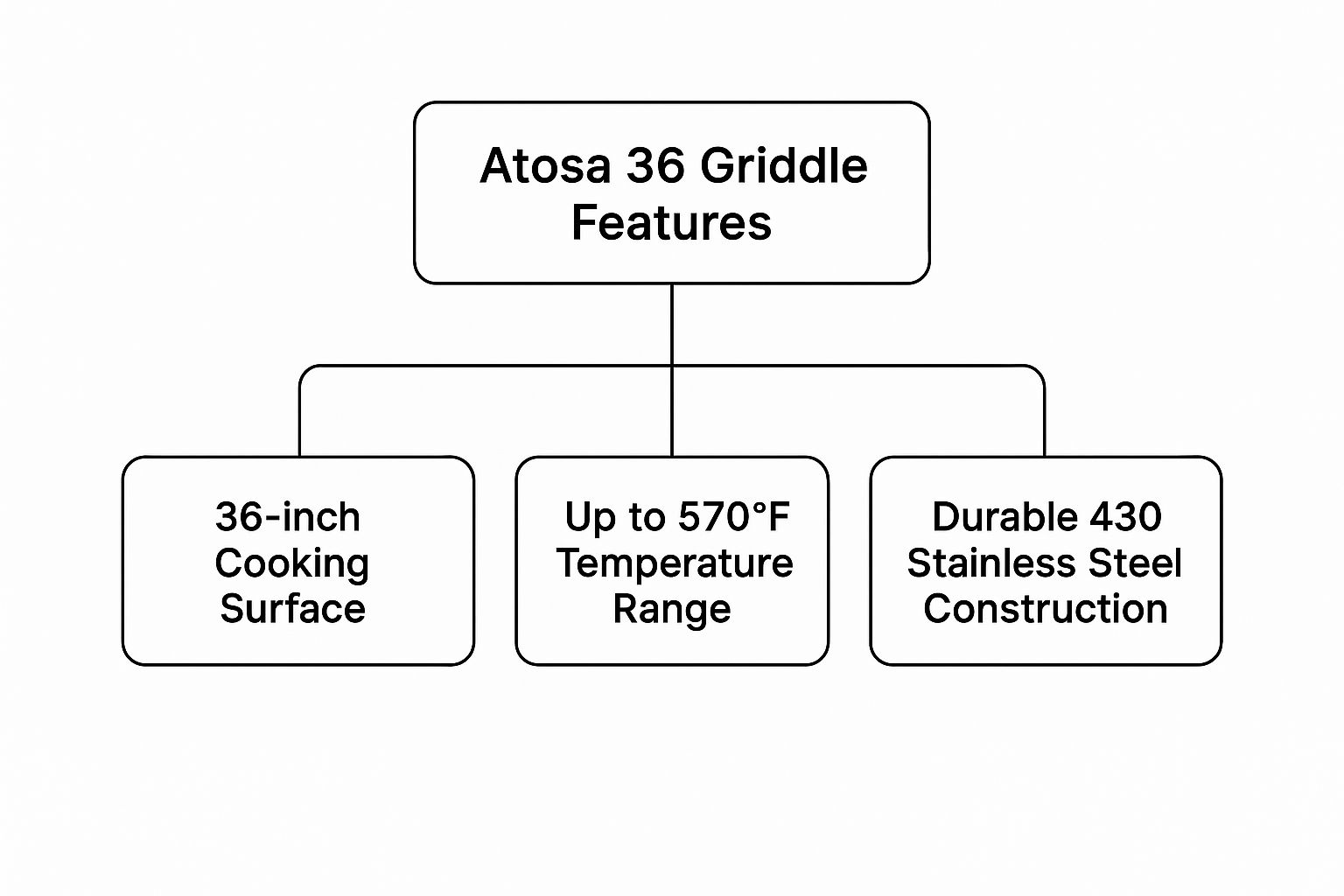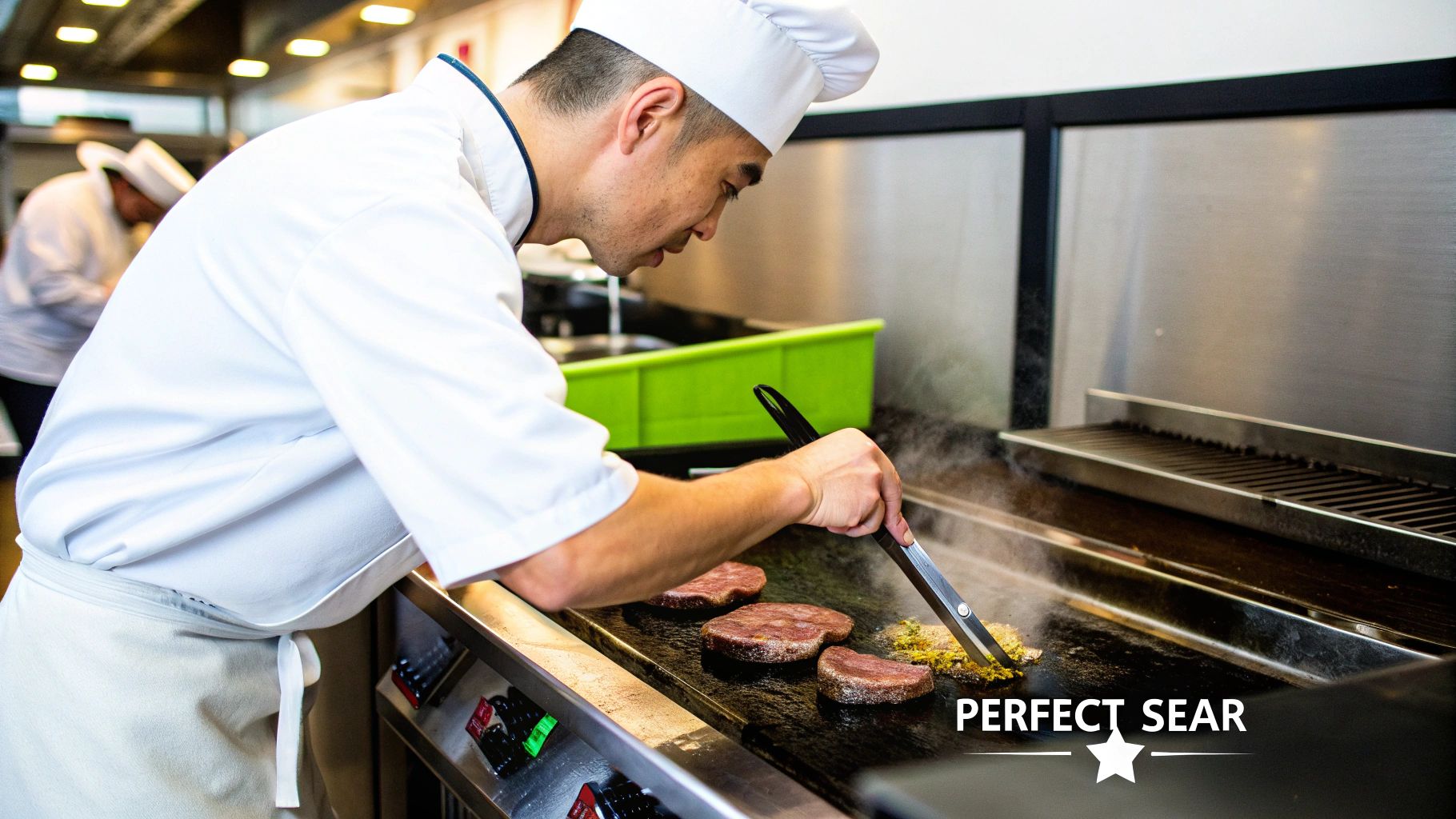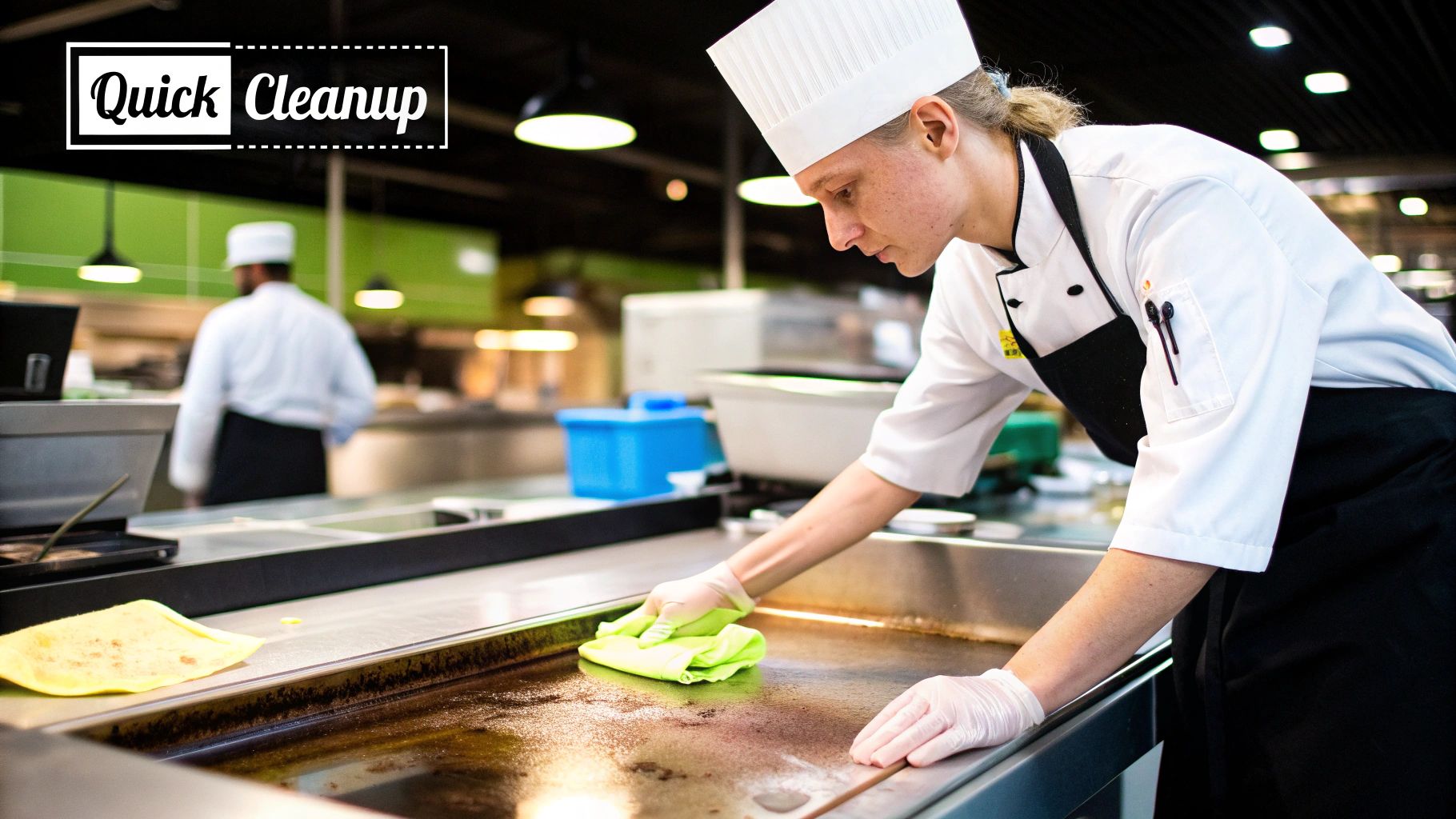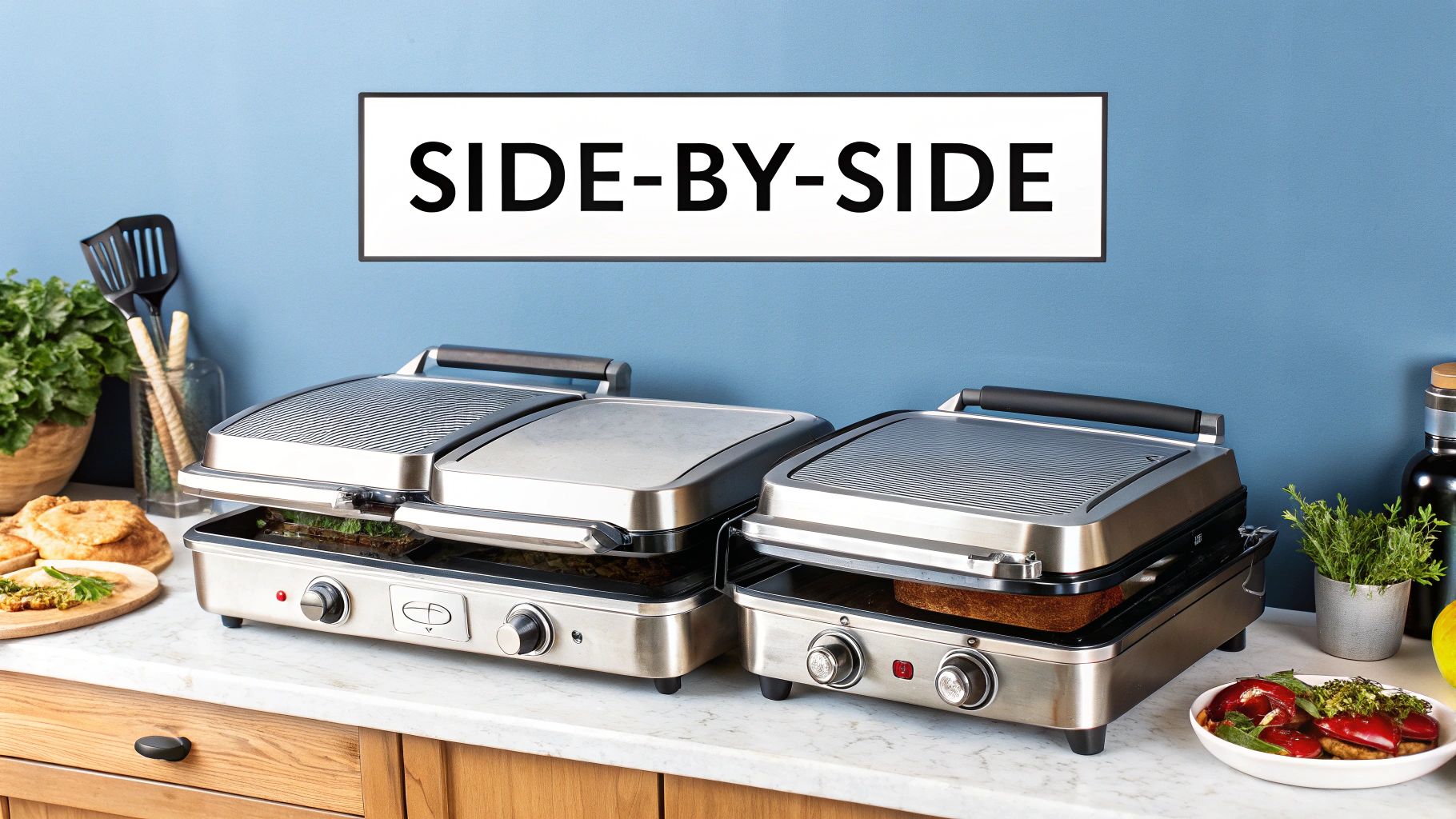
Your Essential Atosa 36 Griddle Guide
In the world of commercial kitchens, the Atosa 36 griddle is a familiar sight. It's built its reputation on a simple, powerful promise: consistent heat, tough-as-nails construction, and controls so simple you can master them in minutes. This isn't just a piece of equipment; for many kitchens, it's the heart of the line, handling everything from the morning breakfast rush to the last dinner service.
Why Kitchens Trust the Atosa 36 Griddle
Walk onto the line in any busy restaurant, and you'll see equipment chosen for one main reason: it just works. Day in, day out. The Atosa 36 griddle has earned its spot because it's the kind of reliable partner you need when the tickets start piling up. It’s not a fancy gadget with a million buttons—it's a fundamental tool designed to cook a lot of food with precision.
When things get hectic, chefs don't want to fight with their equipment. They need a griddle that fires up fast, holds its temperature without wavering, and can take a beating from spatulas and scrapers all day long. That's exactly where this Atosa model shines.
The Foundation of Kitchen Efficiency
The real test of any kitchen gear is how it affects your speed and output. A great commercial griddle makes the whole kitchen run smoother, and the Atosa 36 does this in a few critical ways:
- Serious Cooking Real Estate: With a 36-inch surface, you can have pancakes, bacon, and eggs going all at once, preventing those dreaded bottlenecks during a weekend rush.
- No-Guesswork Heat: The reliable temperature control means food cooks evenly every time. That translates to less waste and a happier bottom line.
- Easy for Everyone: The controls are intuitive. New cooks can get comfortable on it quickly, which helps keep service moving without a hitch.
- Built to Last: A full stainless steel body means it’s made for the daily grind. You'll spend less time and money on repairs and more time cooking.
This combination ensures that from the first sizzle of the day to the final sear at night, this griddle just does its job. If you want to dig deeper into what makes this brand a go-to choice, check out our full guide on the Atosa griddle and how it fits into a pro kitchen.
This griddle was clearly designed for the chaos of a real commercial kitchen. It’s built to be a profit center, not a maintenance headache that needs constant babysitting.
At the end of the day, trust is earned. Kitchens put their faith in the Atosa 36 griddle because it delivers on durability and consistency, freeing up chefs to do what they do best—make incredible food.
Getting to Know the Atosa 36 Griddle
To really get why the Atosa 36 griddle is a workhorse in so many professional kitchens, you have to look past the shiny stainless steel. Its performance isn't an accident. It’s the direct result of smart engineering choices made for one reason: to stand up to the chaos of high-volume cooking and keep on going.
The heart and soul of this griddle is its massive, 3/4-inch thick polished steel plate. Don't just think of it as a flat surface for cooking. Think of it as a thermal battery. Its sheer weight is fantastic at soaking up and holding onto heat, which means when you slap a dozen cold burger patties on it, the temperature doesn't just crash. This is what gives you a consistent, hard sear every single time.
This visual breaks down the key specs at a glance.

As you can see, the large cooking area, wide temperature range, and tough-as-nails materials are what make this griddle tick.
The Power and Control Behind the Cooktop
Let's talk about what's really driving this machine: pure power. The Atosa 36 griddle cranks out a total of 90,000 BTUs. That number isn't just for show—it translates directly to lightning-fast recovery times. When your griddle gets back up to temp quickly, your kitchen can fire out more tickets without getting bogged down, which is everything during a dinner rush.
That power is split across three 30,000 BTU burners, and here’s the best part: you control each one independently. This is a game-changer for anyone who needs to multitask on the line. You can essentially create different heat zones across the 36-inch surface.
- Zone 1 (Screaming Hot): Perfect for getting that beautiful crust on burgers or searing steaks.
- Zone 2 (Steady Medium): Your go-to for cooking pancakes, eggs, and grilled cheese sandwiches without burning them.
- Zone 3 (Low/Warming): A great spot for toasting buns or holding finished food for a minute before it hits the plate.
Having the ability to handle three different tasks on one piece of equipment is a huge win in any kitchen where space and time are tight.
Let's break down the technical details and what they mean for your daily grind.
Atosa 36 Griddle Key Specifications Overview
| Feature | Specification | Benefit for Your Kitchen |
|---|---|---|
| Total BTU Output | 90,000 BTUs | Fast heat-up and quick recovery times mean less waiting and more cooking, especially during peak hours. |
| Burners | 3 independently controlled burners | Creates multiple heat zones, allowing you to sear, cook, and warm all at the same time on one surface. |
| Griddle Plate | 3/4-inch thick polished steel | Acts like a heat reservoir, preventing temperature drops and ensuring a consistent sear on every order. |
| Construction | Stainless steel exterior and interior | Built to withstand the daily abuse of a commercial kitchen while making cleanup much easier. |
| Grease Management | Full-width grease trough & large removable pan | Simplifies end-of-day cleaning, saving your crew valuable time and effort. |
These specs show that the griddle is designed not just for performance, but for the practical realities of kitchen life.
Built for the Grind of a Real Kitchen
Beyond raw power, the Atosa ATMG-36 Manual Gas Griddle is built to last. The entire unit, inside and out, is made from stainless steel. It can take a beating from spatulas, pans, and constant scrubbing without falling apart. You can learn more about its tough build and how it handles high-volume demands on Rapids Wholesale.
The griddle’s design isn't just about heat; it's about control. The multi-zone capability transforms it from a simple flat top into a versatile cooking station that adapts to your menu on the fly.
Finally, Atosa didn't forget about the cleanup crew. Practical touches like a full-width grease trough that funnels everything away and a big, easy-to-remove grease pan make closing down faster. These are the kinds of thoughtful details that make a piece of equipment a long-term asset, not just another headache to maintain.
Putting the Griddle to Work in Your Kitchen

Specs on a page are one thing, but how does the Atosa 36 griddle hold up when the tickets are flying and the pressure is on? This is where a list of features becomes your line's command center, making a real difference in your workflow and ticket times.
Think about a chaotic weekend breakfast rush. That huge 36-inch surface suddenly becomes the most valuable player in your kitchen. One cook can have a dozen pancakes going on one side, keeping them perfectly golden, while another zone is sizzling up bacon and frying sunny-side-up eggs. This isn’t just about cooking more food; it's about organized, high-volume production.
From Morning Rush to Lunch Crush
When breakfast service rolls into lunch, the griddle switches gears without skipping a beat. Now, it's a burger-making powerhouse. The heavy steel plate gives you that perfect, crusty sear on smash burgers, while you can set an adjacent burner zone lower to gently toast stacks of brioche buns.
That ability to create separate, distinct heat zones is what really separates a professional griddle from others. You’re not just cooking; you're orchestrating the entire flow of the line. A single piece of equipment handles multiple steps of the process, which means less running around for your cooks and faster plating.
The real magic of the Atosa 36 griddle isn't just its size—it's the flexibility to run different temperatures across its surface at the same time. This lets a smaller kitchen punch well above its weight, expanding the menu without cramming in more equipment.
Atosa has built a solid reputation for reliability, becoming a go-to supplier for high-demand places like hotels and catering operations that just can't afford downtime. The Atosa 36 griddle—with its 90,000 BTU output and generous 36" W x 20" D cooking area—is built from the ground up to meet these demands, so you can turn over orders quickly without sacrificing quality.
Expanding Your Dinner Service Potential
Come dinner time, the griddle proves its worth all over again. The high-heat zones are perfect for getting a beautiful sear on salmon fillets or a nice char on vegetables like asparagus and bell peppers. At the same time, you can use a lower-temp zone to warm flatbreads or hold sauces for plating.
This all-day adaptability is what makes it a cornerstone of a profitable kitchen. It doesn't matter if you're hooked up to natural gas or propane; that consistent output is what counts. Figuring out which fuel source is best for your setup can squeeze even more performance out of your unit. For a deeper dive, check out our guide on the differences between natural gas vs propane.
In the end, this griddle does more than just cook food. It solves real operational problems, one perfectly seared dish at a time.
Getting Set Up: Installation and Seasoning
So you’ve got your new Atosa 36 griddle. Now comes the important part: getting it set up for a long life of high performance. A proper installation isn't just about flipping a switch; it’s about laying the groundwork for safety, efficiency, and incredible food.

While the griddle itself is built for simple operation, the initial hookup is strictly a job for a professional. You’ll need a licensed technician to handle the gas lines, whether you're using natural gas (NG) or liquid propane (LP). This isn't the place to cut corners—it’s a critical safety step that protects your kitchen, your staff, and your investment by ensuring everything is up to local code.
Your Pre-Launch Installation Checklist
Before that first sizzle, there are a few things to double-check. Think of it like a pre-flight inspection for your kitchen's new powerhouse. A pro will take care of these, but it’s always good to know what’s going on.
- The Right Gas Connection: Your technician will make sure the gas line is correctly sized and locked down tight. This prevents dangerous leaks and ensures the burners get the fuel they need to hit that full 90,000 BTU output.
- Proper Ventilation: This is non-negotiable. The griddle must be installed under a commercial-grade ventilation hood. It's the only way to effectively pull out heat, smoke, and grease from the air, keeping your kitchen safe and compliant with fire codes.
- A Level Playing Field: The installer will adjust the griddle’s feet until the cooking surface is perfectly level. If it's tilted, even slightly, oil and grease will pool to one side, leading to unevenly cooked food and a mess you don’t want to clean up.
The most overlooked part of installation is often the simplest: making sure the unit is perfectly level. It’s a small detail that has a massive impact on achieving consistent cooking results across the entire 36-inch surface.
The Art of Seasoning Your Griddle Plate
Once your griddle is safely installed, it’s time for the most important ritual: seasoning the griddle plate. This isn’t just a cleaning task; it’s how you create that beautiful, naturally non-stick surface that seasoned chefs swear by. Seasoning is simply the process of bonding a thin layer of cooking oil to the steel through heat, creating a hard, protective layer called a patina.
This slick surface is what keeps food from sticking and protects the steel from rust. A well-seasoned Atosa 36 griddle just gets better with age, becoming easier to cook on and a breeze to clean. To get this just right, check out our complete guide on how to season a new griddle. Nail these first steps, and you’ll be set for years of reliable, headache-free cooking.
Mastering Your Cleaning and Maintenance Routine
If you want to protect your investment in an Atosa 36 griddle, it all boils down to one simple habit: consistent cleaning. A clean griddle isn't just about safety—it's the secret sauce for consistent cooking, preventing weird flavor transfers, and making sure your gear lasts for years to come. Think of this routine less as a chore and more as a core part of running a pro kitchen. It pays off every single day.

The daily cleanup is your first line of defense. It needs to happen at the end of every single service and only takes a few minutes. While the griddle is still warm (but not blazing hot), grab a griddle scraper and get all the food bits and grease off. This one simple step prevents that tough carbon buildup that leads to hot spots and messes with your cooking.
After that initial scrape, give the surface a quick wipe with a damp, food-safe cloth to catch any leftover residue. The last step? Empty and clean out that large grease trap. This is huge, not just for hygiene but for fire safety, too.
Your Essential Daily Shutdown Procedure
To make sure your team gets this right every time, turn it into a simple checklist. A consistent routine means nothing gets missed, even when everyone's exhausted at the end of a long shift.
- Scrape the Surface: While the griddle is still warm, use a heavy-duty scraper to push all food scraps and extra grease down into the trough. A warm surface makes this job way easier.
- Wipe Down: Use a damp cloth or a griddle pad to wipe the cooking plate clean. Don't even think about using steel wool or anything super abrasive—it will destroy the seasoned surface you've worked so hard to build up.
- Empty the Grease Trap: Carefully pull out the grease pan, get rid of the gunk properly, and give it a good wash with soap and water. A clean trap is your best friend for preventing overflows and nasty smells.
- Final Polish: Once it's clean, spread a super thin layer of cooking oil across the griddle plate. This is what protects the steel from rust and keeps that non-stick patina in great shape for the next service.
A well-maintained griddle plate is just like a cast-iron skillet—it honestly gets better with age. The daily routine of scraping, cleaning, and re-oiling isn't just about being clean; it’s about actively making your cooking surface better over time.
Deeper Maintenance for Long-Term Health
Beyond the daily wipe-down, you need to do some periodic deep cleaning and inspections to ensure the long-term health of your Atosa 36 griddle. Once a week or maybe once a month, depending on how hard you run it, take a few extra minutes to check the burner ports. Make sure they're clear of any blockages, because clogged ports will give you an uneven flame and inconsistent heat.
In the commercial kitchen world, everyone wants equipment that's reliable and easy to maintain. It's a huge deal. The global teppanyaki/griddle market was valued at around $1.2 billion in 2024 and is expected to hit $1.77 billion by 2032. That kind of growth shows just how much the industry values tough, high-performance units like the Atosa 36 that are built to last—as long as you take care of them. You can discover more insights about the commercial griddle market on Verified Market Research. This little investment of your time makes sure your griddle stays a dependable workhorse.
Your Top Questions About the Atosa 36 Griddle
When you're about to invest in a kitchen workhorse like the Atosa 36 griddle, you’re bound to have a few questions. That's a good thing. Getting straight answers is how you make sure this griddle is the right fit for your specific kitchen. We've gathered the most common questions we hear from chefs and owners right here.
Forget the dry spec sheets. We're talking practical, real-world info that will help you hit the ground running from day one.
Can This Griddle Run on Propane Instead of Natural Gas?
Absolutely. One of the best things about the Atosa 36 griddle is its fuel flexibility. It comes ready for natural gas (NG) right out of the box, but a liquid propane (LP) conversion kit is included.
This makes it a fantastic option whether you’re in a traditional restaurant with a gas line or running a food truck that lives on propane tanks. Just remember, this isn’t a DIY job. You’ll need a certified technician to make the switch to keep everything safe, up to code, and under warranty.
How Long Does It Take to Heat Up?
For its size, the Atosa 36 griddle gets hot fast. With a massive 90,000 BTUs firing up under that heavy plate, you can expect it to reach cooking temperature in just 15 to 20 minutes.
This quick preheat time is a lifesaver during a busy service. It cuts down on waiting and lets your crew get right to cooking. Plus, that thick 3/4-inch steel plate holds onto heat like a champ, so it bounces back quickly even when you slap down a bunch of cold burgers.
It's not just about how fast it heats up initially—it's about how fast it recovers. That ability to hold a steady temp during the dinner rush is what separates a pro-level griddle from the rest.
What's the Best Temperature for Seasoning?
Aim for a sweet spot between 350°F and 400°F for that first crucial seasoning. This temperature is just right for the oil to polymerize—that’s the science-y term for creating the tough, non-stick surface you want—without just smoking and burning off.
Keeping the heat steady in this range helps the oil bond to the steel, creating that slick, durable finish that will make cooking and cleanup a dream for years to come.
Ready to make the Atosa 36 griddle the new heart of your kitchen? At Griddles.com, we’ve got this powerhouse in stock with free shipping and fast delivery. Explore the Atosa 36 Griddle and upgrade your line today!
